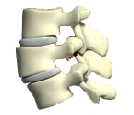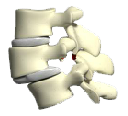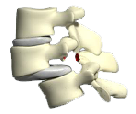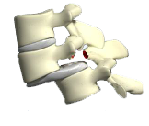Spondylolisthesis
Spondylolisthesis refers to a slippage where one vertebra slips in relation to the vertebra below. Forward slippage is the most common type, but sideways slippage called lateral listhesis and backward slippage called retrolisthesis, are also quite common. Spondylolisthesis may cause back pain, but also may cause buttock and leg pain as well.
SPONDYLOLISTHESIS TYPES
 Type 1 is a dysplastic spondylolisthesis which is a congenital abnormality where portions of the supporting facet joints, either from the bone above or the bone below at that level, are missing or deficient.
Type 1 is a dysplastic spondylolisthesis which is a congenital abnormality where portions of the supporting facet joints, either from the bone above or the bone below at that level, are missing or deficient.
 Type 2 is isthmic or spondylolytic, in which there is actually a defect in the region called the pars interarticularis, which is a connecting region between the front of the spine and the joints where one vertebra meets its mating bone below. Type 2 can also be divided into different categories: Type 2A is a lytic or stress spondylolisthesis caused by hyperextension and is more common in males. In type 2B, the pars region also has been damaged with micro fractures but has been stretched out and healed with new bone. Type 2C is rare and traumatic where there is an acute fracture of the pars interarticularis.
Type 2 is isthmic or spondylolytic, in which there is actually a defect in the region called the pars interarticularis, which is a connecting region between the front of the spine and the joints where one vertebra meets its mating bone below. Type 2 can also be divided into different categories: Type 2A is a lytic or stress spondylolisthesis caused by hyperextension and is more common in males. In type 2B, the pars region also has been damaged with micro fractures but has been stretched out and healed with new bone. Type 2C is rare and traumatic where there is an acute fracture of the pars interarticularis.
 Type 3 is a degenerative spondylolisthesis. Degenerative spondylolisthesis happens in the setting of patients with disc degeneration and enlarged facet joints, which are the supporting joints in the spine. It is often more frequent in women and is one of the most common causes of debilitating back and/or buttock and leg pain.
Type 3 is a degenerative spondylolisthesis. Degenerative spondylolisthesis happens in the setting of patients with disc degeneration and enlarged facet joints, which are the supporting joints in the spine. It is often more frequent in women and is one of the most common causes of debilitating back and/or buttock and leg pain.
 Type 4 is a traumatic spondylolisthesis secondary to fractures of one of the supporting structures in the back of the spine including the facets, lamina or pedicle.
Type 4 is a traumatic spondylolisthesis secondary to fractures of one of the supporting structures in the back of the spine including the facets, lamina or pedicle.
Type 5 is a pathologic spondylolisthesis which is secondary to tumor.
SYMPTOMS OF SPONDYLOLISTHESIS
Although many people who have spondylolisthesis are asymptomatic, patients can develop back pain. Often patients are asymptomatic for many years and develop pain after a prolonged period of symptom-free time. Many patients develop leg pain, and this is secondary to spinal stenosis where the nerves traveling down the spinal canal or leaving the spine through the foramen can be pinched and irritated. Commonly people present with hamstring tightness, and in some cases, their may be an obvious slippage of the vertebrae when examining the patient’s lower back, including dimple formation at the sight of the slippage. Patients typically have pain with hyperextension.
THE DIAGNOSIS OF SPONDYLOLISTHESIS
Although spondylolisthesis was first described by an obstetrician while performing a pelvic exam, one can see a significant deformity when looking at the patient’s skin over the lumbar spine. However, more commonly spondylolisthesis is diagnosed with an x-ray, CT scan or MRI of the lumbar spine.
Typically spondylolisthesis is graded into degrees ranging from 1 through 5, where grade 1 represents a slippage up to 25%, grade 2 up to 50%, grade 3 up to 75%, grade 4 greater than 75%, and in the case of a condition called spondyloptosis, this is an extreme example that is considered a grade 5.
SPONDYLOLISTHESIS TREATMENT
Most people without neurologic impairment are successfully treated with non-surgical modalities. Spondylolisthesis relief can be found through use of anti-inflammatories, physical therapy, and rest. At times, epidural spinal injections and bracing may be indicated. When a patient develops significant neurologic dysfunction or has a failure of conservative treatment, surgery often can help. Surgical procedures that may be recommended include spinal decompression where nerve compression is relieved surgically, and/or a spinal fusion where the slipping vertebrae are welded biologically to fuse together, which can prevent instability that occurs with spondylolisthesis. Typically, most patients can be treated successfully nonoperatively.
